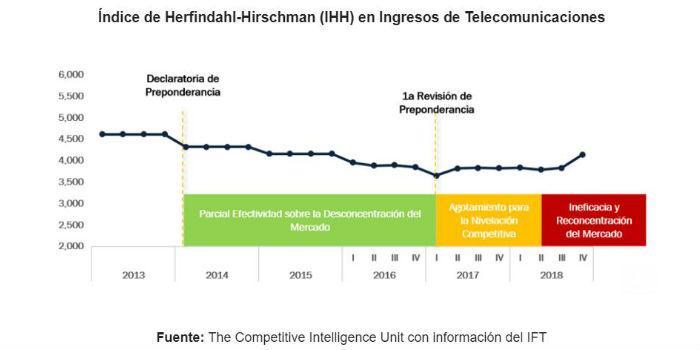 Mexico. In March 2014, the Plenary of the Federal Institute of Telecommunications (IFT) approved an agreement that ordered regulatory measures in the search for full competition in the telecommunications sector, based on the decrease in the market share of the group of companies that make up the Preponderant Economic Agent in the telecommunications sector (AEP-T).
Mexico. In March 2014, the Plenary of the Federal Institute of Telecommunications (IFT) approved an agreement that ordered regulatory measures in the search for full competition in the telecommunications sector, based on the decrease in the market share of the group of companies that make up the Preponderant Economic Agent in the telecommunications sector (AEP-T).
Five years later, these measures have not prevented the AEP-T from maintaining and increasing its market power and even seeking to expand its dominance, requesting authorization to expand its services to the audiovisual content transmission segment. All in a context of full and deficient non-compliance with the measures imposed.
Concentration Metrics: The Herfindahl-Hirschman Index (IHH)
In a first phase (Partial Effectiveness on Market Deconcentration), asymmetric regulation paid off, as shown by the Herfindahl-Hirschman Index (HHI) in terms of revenue that measures market concentration in the telecommunications sector.
The IHH went from 4,320 points in March 2014, when the regulatory measures were approved, to 3,652 in March 2017, the month in which the first biennial review, modification and addition of asymmetric measures concluded, according to the consultancy The Competitive Intelligence Unit (The CIU). However, from that moment the index rebounded and began to register increases to the point that, by the end of 2018, the last moment for which information is available, the IHH of the sector reached 4,142 points, resulting in two phases: Exhaustion for Competitive Leveling and Ineffectiveness of Asymmetric Regulation and Market Reconcentration, as indicated in the graph below.
This coincides with the elimination of the asymmetric interconnection tariff regime, as defined at the beginning of this compensatory period; with the resilience of the AEP-T to effectively comply with the measures imposed by the IFT; and the lack of effective supervision by the IFT of compliance with the measures and the corresponding sanctions that would have resulted from such adequate supervisory work.
This situation is reflected in the high concentration that this agent maintains in the sector, not only in revenue but also in market share, despite the asymmetric regulation imposed.
In April 2016, when the IFT initiated the first biennial review of asymmetric measures, the AEP-T had 61% of users in the sector while by December 2018 this portion had barely dropped to 59.1% of users. What is worrying is that during that same period, the preponderant agent increased its share of the sector's revenues from 59.8% to 62.1% in the same period. At the same time, in that same period its investment decreased, going from just over 23,900 million pesos in 2014 to just around 15,700 million pesos last year.
In the time from March 2014 to today, it has become clear that asymmetric regulation has failed to sustain the conditions conducive to an even field in the sector, for two fundamental reasons: a) a possible poor design of several of the measures that were imposed; and (b) poor oversight and virtually no willingness to impose sanctions.
Decisions such as the reversal or rebalancing of the interconnection tariff, the delays of the AEP-T to make effective the access of its competitors to its infrastructure as mandated by said agreement and the use of commercial practices such as the offer of non-replicable tariffs for its competitors. With this set of actions, this AEP imposes conditions that damage competition and thus violate the well-being of Mexicans by having less competitive offers in voice, data and audiovisual entertainment services.
It is worrying that despite the above and the time that has elapsed, there are still no transparent mechanisms to know the location and use of the AEP-T infrastructure, which makes it difficult to comply with the measures decreed by the IFT. This was even recognized by the regulator during the first biannual review on the effectiveness of the measures imposed on this agent in 2016.
At IDET we are convinced that five years after the implementation of the measures imposed on the EPA-T, the results achieved do not allow their relaxation given their partial compliance.
The regulatory body of telecommunications in the country has the responsibility to enforce in a verifiable way imposed conditions such as the elimination of barriers to access to its infrastructure, as well as establish the prohibition to offer audiovisual entertainment services both to companies that were declared as part of the preponderant economic agent since 2014, as well as all those affiliates, subsidiaries, affiliates or any other that is related to the preponderant, until it not only fully complies with the measures derived from the agreements P/IFT/EXT/060314/76 and P/IFT/EXT/270217/119 of the IFT that base the asymmetric regulation that it has been required to comply with, but also, that these measures have contributed to generate an environment of effective competition in our country.
Otherwise, the telecommunications sector in Mexico will continue to suffer adverse conditions to the full development of one of the most effective platforms for the economic and social growth of the country.
Text written jointly by the Institute of Telecommunications Law, IDET, and The Competitive Intelligence Unit, CIU.

























Leave your comment